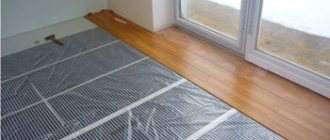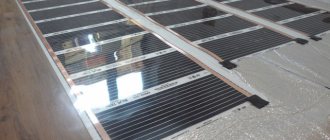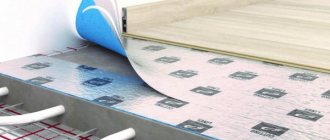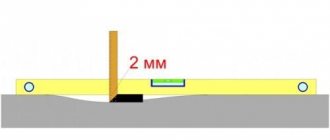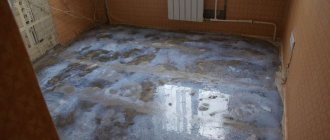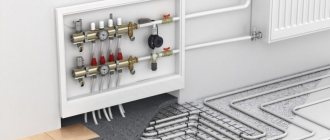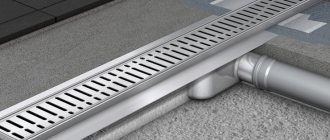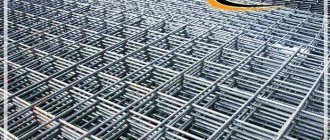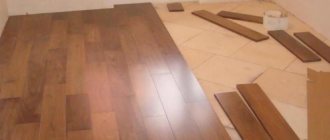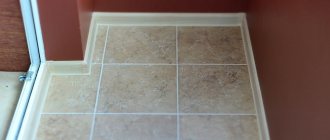Warm floors are a practical, modern and efficient heating system that is gaining popularity and is actively used in new apartments. It is not very expensive and is accessible even to citizens with average incomes. In addition, unlike a water system, infrared heated floors under laminate are much easier to implement, which is another plus.
Principle of operation
Conventional heating systems operate using a direct heat exchange scheme. For example, batteries receive energy from hot water, which is heated at a nearby boiler house. This energy is then transferred to the air in the room, thereby spreading heat throughout the room. The same thing happens when using electric heaters, only the heating element is heated there.
In heated floors created on the basis of water or electric (not infrared) systems, the simplest heat exchange also occurs, only in this case the screed, under which the cable or pipes are located, is heated. The disadvantage of such systems is inertia. To preheat the floor, you need to spend a lot of resources, but the cooling of the floor when the power is turned off occurs slowly, since the pipes or cables under the screed do not cool down for some time.
Film heated floors under linoleum or tiles work differently. Here, under the surface (tile, linoleum or laminate) there are transparent polyesters with carbon-coated strips (or paste). Each strip is connected to a copper bus—voltage is applied to it. When current passes through carbon paste, a radiation flux with waves 5–20 μm in length is created. The film itself and the tire heat up very little. The infrared energy flow created warms the surfaces it hits, and in this case it is the floor. Consequently, in infrared systems there are no intermediate surfaces through which heat is transferred; here the floor itself is heated - it is this that is the first and last “obstacle” to heat. An analogue is the sun, which is also a source of thermal infrared radiation. Its rays heat surfaces encountered along their path.
The operating principle of infrared systems has long been known and is successfully used in wall, ceiling or wall-mounted heaters. It has successfully proven its effectiveness over the years. With the development of technology, we have learned how to lay infrared heated floors under a laminate or other covering. This became possible due to the development of carbon-coated film heaters.
System design
In principle, such a floor consists of two layers of polymer with a heating element between them. This heating element emits infrared rays. Products are made from carbon nanostructure in strips. The width of the strip is 1.5 m. Such material is connected to each other by a copper busbar with a special silver coating, which acts as a current conductor.
The polymer is hermetically sealed, so the flooring is absolutely safe, transmitting exclusively infrared radiation.
Advantages
There are a number of advantages inherent to these systems:
- Film thickness - 0.5 mm. This allows you to hide it under any covering, even thin linoleum. This same advantage allows you to implement a film heated floor with your own hands, since the labor-intensive work of pouring and screeding is eliminated. Also, this solution does not involve raising the floor level by centimeters, which is often the reason for using such a system in apartments with low ceilings.
- Uniform floor heating and stable temperature. If the heating elements are located under the laminate, which is very sensitive to temperature changes, then in the case of electric (non-infrared) or water systems there is a possibility of its damage due to a breakdown of the thermostat. When heated above 40 degrees, it may swell or diverge the seams. When using film systems, heating above 40 degrees is impossible even with a faulty thermostat, so laminate or linoleum or tiles will not be damaged.
- In multi-storey buildings, the use of classic underfloor heating systems is sometimes impossible due to the need to fill, which can make the structure heavier. The only possible option is the use of film infrared systems.
- Flexibility - the system can be implemented in all rooms, even with high humidity. You can install infrared heated floors under tiles, laminate, linoleum, or parquet boards. That is, the system can be implemented even in a bathroom or toilet, but since these rooms have a high level of humidity, and water always gets on the floor, grounding or the presence of a protective shutdown device in the electrical circuit is mandatory.
- Energy transfer begins almost instantly when power is turned on. This allows you to quickly bring the room temperature to a comfortable one. Such a system works perfectly with fashionable “smart home” technology and is programmable. That is, you can set the exact time for turning the heating on and off or specify the required temperature - it will be maintained in the room all the time.
- Unlike conventional electric or water radiators, infrared heated floors under linoleum do not burn oxygen or dry out the air, which is especially pleasant for people suffering from chronic respiratory diseases.
- No vortex flows. Conventional radiators on the walls draw in cold air from below and release hot air from above, which moves to the top of the room, cools and sets. As a result, powerful streams are created that drive dust around the room. The infrared floor heats up evenly and slightly, which eliminates point turbulence.
Well, the last plus is the price. Installation of a film heated floor under linoleum will cost much less than the implementation of complex water cooling of the floor. We are talking about the cost of installation, not the film itself. However, depending on the manufacturer, the film itself may be cheaper than “outdated” floor heating systems.
Materials Basics
The quality of work and service life of a heated floor laid under laminated panels depends on the parameters of the purchased equipment and material, coupled with an understanding of the features of their combination.
To independently develop a layout for infrared stripes, it is necessary to take into account the physical features of such heating.
Parameters of infrared film floor
A film heater is a flexible, narrow sheet placed under the floor covering and containing a heating element. It converts electrical energy into infrared heat waves.
Heating of a laminate or other material occurs from below due to radiation hitting it. After heating the floor surface through its thickness, heat is released into the air of the heated room.
Image gallery
Photo from
IR floor heating device for laminate flooring
Laying infrared panels indoors
Components of a laminate floor with heating system
Easy to cut and install system
The heating element of IR systems is carbon continuous or striped coating, covered on both sides with lavsan or polyurethane film. Current-carrying bimetallic busbars are installed along the edges of the canvases, transmitting energy to the heating element.
The thickness of this design varies from 0.2 to 2 mm, most often panels with a thickness of 0.3 to 0.5 mm are available for sale. Standard width sizes for one strip are 50, 60, 80 and 100 cm.
The ability to purchase infrared heated floors of varying widths by the meter allows you to implement almost any arrangement of heating strips
Any film can be cut to length in places specially designated and marked for this purpose. The cutting step is approximately 20 cm, so you can easily obtain panels of the required length.
The maximum power of infrared film for laminate is from 120 to 230 W/sq.m. Devices with high heat generation are not used due to the limited heating temperature of the laminate. Sometimes, the manufacturer indicates power depending on the linear meter. In this case, dividing it by the bandwidth can calculate the desired value.
Requirements for laminate as a coating
An ordinary laminate may have three properties that prevent its use as a topcoat in combination with a heated floor:
- curvature of plate geometry under high temperature;
- pressing through the plates when exposed to heavy objects;
- high thermal insulation properties of the material.
Therefore, improved models have been developed for the joint use of laminate and the film heated floor located underneath. They are marked with special symbols placed on the packaging of the material or in the instructions for it.
There is no uniform marking standard, so when purchasing, you need to clarify this issue with the seller, since there are solutions only for water or electric cable heated floors.
A schematic representation of a heated floor shows the possibility of using laminated panels from this batch together with it. It is also recommended to use material of safety class E1 or E0 with a minimum content of free formaldehyde
The total value of the thermal resistance coefficient of the laminate and the substrate on which it is laid should not exceed 0.15 sq.m*K/W. Therefore, when choosing a material, it is necessary to ensure that this technical specification complies with regulatory requirements, otherwise there is a risk of overheating and breakdown of the heated floor system.
The connection of the lamellas can be made using glue or locks located at the ends of the plates. In combination with a heated floor, only a floating design of a laminated floor made from interlocking panels is allowed.
Those. The covering assembled from panels should not have a rigid adhesion to the base, and a gap must be left around the perimeter of the room, around architectural details and pipe penetrations as a reserve for linear expansion of the material.
Laminate is produced by pressing sawdust with the inclusion of resins containing formaldehyde. The manufacturer indicates the maximum permissible heating temperature, above which the toxic substance begins to evaporate. This usually happens when it reaches 28-30 degrees Celsius. When calculating heat release, this factor must be taken into account.
The arguments in favor of installing an infrared heating system under laminate and comparing the advantages of IR film with water-based options are detailed in the following article, which we recommend that you read.
Rules for placing underfloor heating strips
The area of a separate room that should be equipped with a warm floor is calculated based on the heating needs of this room.
In the absence of other heating systems, an average of 70% coverage of the total area is sufficient. In the presence of radiators and fireplaces, the need for heat from the floor is reduced, which leads to a decrease in the number of laid strips or less energy consumption for heating.
Due to the existence of restrictions on the maximum power supplied to a residential property, it is necessary to calculate the load on the network
The absence of the need to place an infrared heated floor under the laminate over the entire area of the room makes it possible, as a rule, to easily bypass the following restrictions when designing:
- Do not place heated floors under heavy objects such as cabinets or sofas with legs. They push through the laminate, which leads to an uneven fit and excess pressure on the film.
- Do not cover heated laminate flooring on top with heat-insulating material, such as carpets or furniture without legs. This leads to disruption of heat transfer to the air and overheating of the system.
- It is necessary to avoid heating the laminate simultaneously from the infrared film and another heat source. The size of the floor area under which film cannot be placed is determined individually for each type of heating device located nearby.
- It is necessary to retreat from walls and stationary objects by at least 3 - 10 cm, depending on the manufacturer's recommendations, since the heating zone in plan slightly extends beyond the boundaries of the film. Elevated temperatures can have a bad effect on baseboards and wallpaper.
When planning the placement of infrared film, they often retreat from the walls at a distance of 50-60 cm. This is due to possible redevelopment or rearrangement of furniture in the future.
A significant distance from the walls leaves a wider range of solutions for changing the design of the room. In addition, residents of the house use the space near the wall much less often than in the middle of the room.
In living rooms, infrared film is often placed in the middle. This placement closes areas where people are often present and allows you to change the arrangement of furniture along the walls.
If the heated floor area is rectangular, then it is better to plan the location of the film fragments along the long side. In this case, the number of strips and, as a result, the operations for their installation, insulation and connection are reduced.
Additional information on the structure
In a vertical section, the heated floor device consists of five layers, each of which has certain requirements. The subfloor must be firm and as level as possible. For a concrete base, it is recommended to level it by pouring a leveling mixture, and for a wooden base, by laying plywood.
The insulation between the base and the heating elements is designed to prevent heat loss. Considering that the heated floor runs on electricity, the substrate should not conduct current.
Therefore, insulation with a reflective surface based on aluminum foil is not used. Most often, roll polyethylene foam insulation or cork backing is used, complete with a reflective layer.
The structure of an infrared floor under a laminate (in construction slang - “pie”) is quite simple. Laying any layer does not require specific knowledge or heavy physical labor
Before laying underfloor heating strips with electrical wiring and a temperature sensor, you must read the instructions included with the kit. The general principles of installation are the same, but there are some nuances regarding the distance between the elements being placed, as well as the method of connecting to the electrical network.
Polyethylene or vinyl film should be used as a substrate located between the heating elements and the laminate. It transmits heat well, but serves as a barrier to water and dust, which should not be allowed to enter the heating strips.
One of the typical representatives of film heating systems is PLEN brand products, the installation and operation features of which are described in detail in the article we recommend.
Alignment
The very first stage is leveling the floor. Naturally, the old coating must be completely removed, the surface washed and dust removed. If small holes remain in the floor slab itself (they can form during the construction of the house), then they can simply be filled with sand.
If the floor is flat, then it is necessary to lay a special material directly on it to reflect thermal radiation. The underlay for film heated floors is inexpensive and is laid over the entire area - close to the walls. To avoid shifting, this material can be attached to the floor with double-sided tape - just glue it around the perimeter. The presence of a heat-reflecting surface increases the efficiency of the heated floor and significantly reduces heat loss through the bottom. If the floor had holes, then this material will completely cover them.
Heating elements are the very “heart” of a warm floor.
- Heat-reflecting material - its purpose is to reduce heat loss. A prerequisite is that it must be non-conductive. Polyethylene foam insulation or cork backing with a reflective layer is suitable.
- The base of the floor is solid and level. To do this, the concrete base can be filled with a leveling compound, and plywood can be laid on the wooden base.
Placement of thermal film
Before placing the film itself, you need to plan its position in the room and draw up an approximate connection diagram for the film heated floor. To do this, you need to know in advance the future location of the furniture in the room, since infrared elements should not be located under a closet or sofa. If there is no clear plan, then it is advisable to place the film at a distance of 60–70 cm from the walls.
In residential premises, a standard arrangement of thermal film is often used: several strips in the center of the room along the long side. When the location has been decided, the film strips must be cut into pieces of the required size and laid on the floor with the copper film down or up (depending on how indicated in the instructions). Moreover, they should be positioned so that the eyeliner is on one side.
The distance of the stripes from each other is individual. One manufacturer allows them to be placed end-to-end (most often), another recommends leaving a space of 3-4 cm between the strips. But no one ever allows stripes to be placed overlapping - this is fraught with overheating and failure.
If the distance between two or three stripes is higher than permissible, this will lead to uneven heating of the floor - there will be less and warmer areas on it with a difference of 2-3 degrees, although they are not easy to notice.
How to install
To neutralize the disadvantages of infrared flooring, it is important to install heating equipment correctly. The structure must be placed in an area where people are often present. It is prohibited to place film equipment under furniture. We recommend planning the room in advance, marking the equipment installation areas, and calculating the power parameters of the model.
The base under the infrared floor is cleared of debris. Condensation should not form on the surface, which is dangerous for any electrical appliances. Installation is carried out on a perfectly flat base, so the area is carefully leveled and dried.
The infrared floor film is cut lengthwise into small strips of 25 cm. A waterproofing layer is installed at the base. The blanks are laid out on the surface in activity zones that have been marked in advance. The material should be 30 cm away from the walls. Small gaps (up to 5 cm) are left between the rows of plates.
The blanks are connected into one structure using wires and terminals. Thermal sensors are placed in the center of the strips, with the cables reaching the regulator. The last device to be connected is the one responsible for setting up the IR technology. A thick polyethylene film is placed on top, then the laminate is installed.
Insulation
The thermofilm usually comes with a special insulating tape with special clamps that are used to connect the floor to the network. Also included are cables, a temperature sensor and a thermostat (not always). Cables usually have a cross-section designed to carry a current of a given power.
Use bitumen film to cover the cut areas of the tire. First of all, they are glued to areas of the side to which wires are not connected. Simply put, it closes “open” contacts. The film must be glued well, that is, without an air bubble. When voltage is first applied, the film heats up, melts slightly and takes the shape of the compound being protected.
On the reverse side of the strip there is an open contact. A clip is attached to each of them - it is included in the kit. You need to install it using pliers so that the special spikes pierce the film and reach the tire itself. The stripped ends of the cable are attached to the clips in accordance with the instructions (it clearly indicates where the phase, neutral, and ground are connected), the open contact is covered with bitumen films. The underfloor heating strips are connected to each other in series so that when voltage is applied they work simultaneously. It is also advisable to fasten them together with tape to prevent them from moving under linoleum or laminate or tiles.
Installation of infrared heated floor
To work you will need:
- Film mats of the required length.
- Adhesive heat-resistant tape.
- An installation kit consisting of contact clips for connecting the strips and the power supply, as well as insulating adhesive tape.
- Thermal reflective mylar backing. The best option is products from the same manufacturer as the heating system.
- Polyethylene film.
- Power wire. Its cross section depends on the characteristics of the film heaters used. In particular, for systems with a total power of up to 1.5 kW, it is recommended to use multi-core copper PV-3 with a thickness of 1.5 mm, and for strips from 1.5 to 3.5 kW - 2.5 mm.
- Temperature sensors: main and backup.
- Thermostat of suitable power.
- A set of hand tools: stripper, pliers, press, construction knife, tape measure, marker.
Laying infrared heated floors under laminate is carried out in several stages.
Preparatory work
First of all, you need to develop an installation project. Laying the film chaotically is stupidity, which will seriously hit the pocket of the owner of the premises. Therefore, on paper to scale, draw a plan of each room, mark the locations of heavy furnishings (wardrobes, sofas, refrigerator, etc.). This will allow you to calculate the exact number of film mats, cables and connecting elements. And also decide on the required power and model of the thermostat.
When calculating the heating area, keep in mind that IR mats should not be laid overlapping, but end-to-end. In addition, maintain a distance of 5-10 cm from enclosing structures and interior items.
FACT! The manufacturer claims that for maximum efficiency it is necessary to cover at least 70% of the room area with the heating system. And when using film mats as additional heating, 40% is enough.
So, when the exact area of installation of the IR system becomes known, you can roughly calculate:
Total power of underfloor heating
Multiply the number of square meters by the capacity of 1 m² of film declared by the manufacturer. For example, 15 m²*150 W/m² = 2.25 kW.
To find out which thermostat is suitable for your system, subtract 20% from the resulting figure. In our example it is 1.8 kW. Accordingly, you will need to purchase a thermostat whose characteristics indicate the maximum load level at 1800 - 2000 W.
Approximate energy costs
The formula is simple:
heated floor area * film power * actual operating time * conversion factor
The latter is the temperature level that is planned to be set on the thermostat. For example, if the system operates stably at 50% power, then Kp = 0.5.
The approximate operating interval of the heating elements can be from 5 to 20 minutes per hour, that is, on average about 12 minutes. Thus, for our example the calculation will be as follows:
15*150*0.5 ≈ 1.1 kW/hour.
1.1*12*24/60 ≈ 5.3 kW/day.
5.3*30 ≈ 159 kW/month.
159 *4.01 rubles/kW (tariff for electricity in the Moscow Region at the beginning of 2022) = 638 rubles/month.
Of course, the calculation is very approximate, since the main variables are variable, and there are many individual, climatic and other factors. Taking them into account, you can more or less accurately calculate electricity consumption and heating costs for the period.
The next task is to prepare the base for installation. Concrete or wood floors must be level, clean, dry and durable. All irregularities must be eliminated, dust removed, and preferably primed with a binder.
Installation of the IR system
If the wires supplied to the thermostat from the panel and from the floor heating system are planned to be “recessed into the wall,” then you should first prepare grooves for the cables and a hole for the dimensions of the thermostat. All debris and dust must be removed after completion of work, and the base must be thoroughly vacuumed. If you don’t want to damage the walls, you can simply secure the wires on top of the enclosing structures and cover them with a white or colored cable channel. And fix the thermostat using dowel nails at a level of up to 1.5 m from the floor plane.
In accordance with the layout plan, markings should be applied to the base and a recess 7 mm deep should be prepared for installing a temperature sensor a meter from the wall. Then lay the heat-insulating material with the reflective surface facing up and fasten the mats together with adhesive tape.
Strips of infrared film are laid end-to-end on top of the substrate, in no case overlapping. According to the manufacturer’s advice, it is best to immediately seal the cutting lines of the copper busbar using adhesive tape. The laid mats must be connected around the perimeter with adhesive tape.
Now you need to properly connect the strips into a single circuit. All elements are connected in parallel, as shown in the diagram below.
Wires are connected to the mats using two methods - using contact clips or soldering.
In the first case, the terminals are attached to the busbar and clamped using a press or pliers. The wires are fixed to them and insulated with bitumen tape.
In the second case, connectors are not needed. The cable is carefully stripped of its insulation and soldered to the copper strip. All connection points are carefully sealed.
IMPORTANT! Laminate flooring is very sensitive to the slightest unevenness underneath. And the backing is usually not enough to hide terminals, wires and sensors. Therefore, experienced craftsmen recommend following GOST R 50571.5.52-2011 part 5-52 and making recesses in the subfloor for all elements. Otherwise, constant pressure will lead to their damage, leakage of bitumen mastic in places of insulation, exposure of clips and copper busbars. At best, one of the IR film strips will fail.
The next step is to fix the main and backup sensors and connect the thermostat. The sensors must be placed in a pre-prepared recess and secured with adhesive tape under the heating part of the film. The cable from them is routed to the thermostat and connected. Next, connect the wires from the IR floor and the electrical network according to the manufacturer's instructions.
Next, you need to check the connection, that is, turn on the system for 15-20 minutes and test all the bands.
Laying laminate or other finishing material
It is necessary to lay a polyethylene film over the heating mats with an overlap of 10-15 cm, and secure the edges. No backing required. Installation of the laminate is carried out as carefully as possible in accordance with the manufacturer's instructions from the far corner. After completing the assembly, you can install skirting boards around the perimeter, bring in furniture and install it in the places indicated on the plan.
Connection
The ends of the cables are connected to the thermostat, which should be mounted on the wall. It may not be included in the kit; sometimes the regulator needs to be purchased separately. In addition to “phase” and “zero”, you also need to connect the temperature control sensor cable to the thermostat. The sensor itself fits under the black stripes of the film - it measures the temperature on them, which allows the system to accurately control the heating. Since the sensor has some volume, it can create a bulge on the floor. To ensure the floor is level, a small hole is cut out in the insulating material for it.
The thermostat is installed on the wall - in a place to which residents have free access. Cables are connected to it: phase, neutral, grounding, from the temperature control sensor. The connection is carried out according to the instructions of the selected thermostat or the heated floor itself, but everything is intuitively clear to a person who at least has experience installing and connecting conventional sockets. If a film heated floor under carpet, laminate or tile is made of several elements, then you cannot twist the wires from them - there are certified terminal connections for this.
Before you connect an infrared heated floor to your home wiring, you need to know what load it is designed for. Most often, if the floor power exceeds 2.5 kW, then the wire from the regulator is led into the panel - to a separate machine. It would be stupid to “hang” such a powerful system on the home wiring. When everything is connected, the system is tested. If everything works fine, then you can proceed to the next step.
Tools and materials
The heated floor system kit consists of:
- infrared film (available in widths of 0.5 m, 0.6 m, 0.8 m and 1.0 m);
- electric wires;
- clip contacts;
- fastening clips for fixing the film;
- bitumen tape.
You should also purchase:
- thermostat and temperature sensor with wire, if they are not included in the kit;
- substrate for infrared heated floor;
- film for waterproofing the system against water spilled on the floor;
- electrical tape;
- roulette;
- masking and household tape;
- pliers;
- scissors.
Laying waterproofing and laminate
To protect the floor elements from water ingress, a waterproofing film is placed on it. It has no relief and is very thin, so it does not affect the efficiency of the installation and freely transmits infrared radiation. The waterproofing layer is not applied over the entire floor area, but on the films themselves with protrusions along the edges. Well, then comes the laying of laminate, tiles, linoleum or parquet boards. This is how you install a film heated floor with your own hands. That is, everything here is intuitive even for the most inexperienced master.
As for laying the flooring, standard schemes are used here.
Laminate selection criteria
Having decided to make an infrared heated floor in an apartment with a finishing coating - laminate, the question arises - what type of lamellas is suitable for such a system. If you lay inappropriate parquet, when heated it will deform, may release harmful substances, and will conduct heat poorly.
The product must:
- have a special marking - “snake”, which indicates the possibility of using it with an infrared heating system;
- have good thermal conductivity - the thermal resistance coefficient should be from 0.05 to 0.10 m2 x °K/W;
- have a thickness of 8 - 9 cm;
- do not emit formaldehyde when heated to 30 degrees, that is, permissible emission class E1 or E0;
- to be wear-resistant - better than 32 or 33 wear resistance classes.
All this information can be found on the packaging.
Exploitation
After the film infrared heated floor is installed under the laminate, it is necessary to save a plan for its placement in the room, indicating the distances from the walls. This will allow you to rearrange the room correctly, moving the furniture elements to areas with infrared stripes. If you need to install any elements on the floor with fastening to the ceiling, then the layout of the heating elements will also come in handy.
When the connection of the infrared heated floor is completed and the floor covering is laid on top of it, it is not recommended to turn on the installation immediately at full power. Linoleum or laminate must “adapt”, so to begin with it is advisable to set the temperature to 15–20 degrees, adding 3–4 degrees every day. If tiles are laid on the floor, the adhesive (or mortar) on which it is fixed must first dry at natural temperature. And a slow increase in temperature will allow you to understand the full efficiency of the film heated floor under the tile or laminate and determine the optimal value.
Which is the best laminate and underlay for an infrared film floor?
Well-known manufacturers of laminated coatings confirm that film heating is perfectly combined with products if a few simple recommendations are followed:
- The maximum power of heating elements should not exceed 60 W/m².
- The temperature of the heated floor is up to +27 ºС (80 ºF).
- If the heating system is installed in local areas under the laminate, then it is advisable to separate the heated zones from the cold ones using expansion profiles.
- A waterproofing film must be placed between the IR floors and the laminate flooring.
Thus, all interlocking laminated coverings can be laid on a base with an infrared heating kit. To be completely sure, you can check that the laminate box will definitely have the appropriate markings.
Let's talk about substrates . One of the biggest mistakes is the choice of a heat-reflecting layer covered with aluminum foil. The fact is that aluminum is a good conductor of electricity. It accumulates capacitive currents, which will be felt as unpleasant vibrations and/or constant shocks of static electricity (electromagnetic induction). And where there is one error, others are possible, related to the connection of elements and their isolation. If the sealing of the contacts is broken, then in combination with the conductive layer, homeowners will be surprised by constant short circuits. And in the worst case scenario involving moisture, there is a risk of receiving severe electric shocks. Therefore, under IR floors, you should use substrates with a lavsan reflective layer. Outwardly, it is similar to aluminum foil, but its structure is softer and does not conduct electricity (dielectric). To know exactly what kind of underlying layer you have, check it with a ring tester.
Manufacturers
Speaking about which film heated floor is better, we can give examples of different manufacturers offering effective solutions. Today the most popular manufacturers are Daewoo, Caleo, Heat Plus
Caleo is considered the best brand - this is a South Korean company that offers cool modern solutions in the form of infrared heated floors for laminate, parquet boards, and tiles. Kaleo films are reliable and durable, very thin; if installed correctly, they will last for ten years, the only drawback is the fragility of the product. The thickness of the film is only 0.42 mm, so when laying infrared heated floors under laminate or linoleum it is necessary to do it very carefully, otherwise you can simply damage the film.
Heat Plus is a popular brand that produces premium films. If you need to install an infrared heated floor with your own hands under the tiles, then with a high probability you will have to choose films from this manufacturer, namely the “Silver” model. It has a high melting point, which makes it safe and effective when used with ceramic tiles.
Features of interaction with laminate
Warm infrared flooring is compatible with tiles and linoleum. Not every board is suitable for a hot surface. For example, PVC models are made from heat-resistant polymers. MDF laminate contains formaldehyde resin, which is used as a fastening ingredient.
The substances are harmless at room temperature (20-27 C), but begin to emit vapors when heated. The operating mode of the infrared floor is 45-55 C. At lower values, the equipment will not warm up the floor covering.
Features of interaction Source uutvdome.ru
Laminate flooring can become deformed when exposed to heat. Boards that are too thin dry out, losing their shape and bending. With constant heating, the finishing material will lose its decorative and performance characteristics.
In order for the laminate to interact without problems with the infrared system, it is important to choose the right model. There is no dangerous formaldehyde in flooring with classes E1 and E0. Even at maximum heating, such boards will not evaporate toxic substances.
To prevent the laminate from deforming under the infrared floor, preference is given to models with a high wear resistance class (31 or more). The lamellas will not bend and will retain their original appearance under constant exposure to increased temperature. The label of the finishing material must contain a marking of the warm system - an icon with a curved pipe.
When purchasing laminate flooring for infrared flooring, we recommend choosing models with a locking connection. If the boards are glued together, then after fixing, a very hard surface is created. With temperature changes and constant physical impact, the connecting layer breaks, which spoils the decorative effect of the finishing material.
What is suitable for IR heating Source krrot.net

